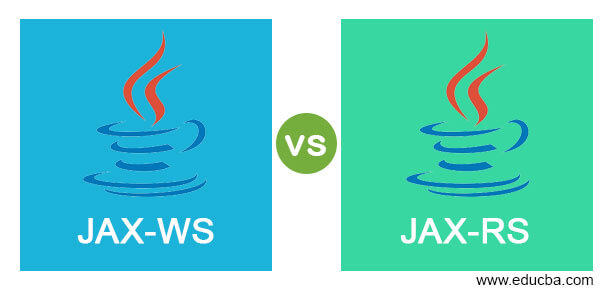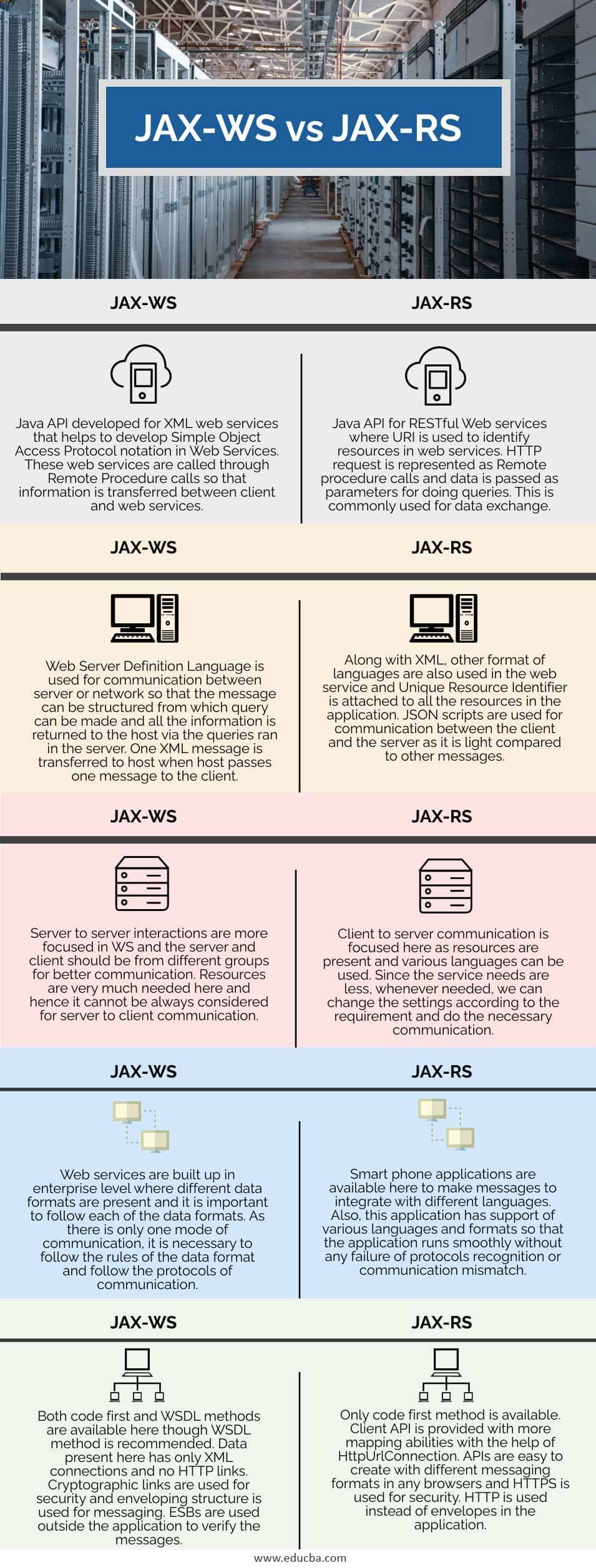Updated April 17, 2023

Difference between JAX-WS vs JAX-RS
Jakarta XML Web Services or JAX-WS is an API for creating web services programmed for SOAP services. Developers can either write message-oriented APIs or Remote Procedure Call Oriented Web Services. It is implemented in Java where we can start it by coding the implementation class and deploying the WAR file. Jakarta RESTful Web Services or JAX-RS supports in creating web services with the help of annotations based on Representational State Transfer Architectural Plan. Annotations are used so that deployments and developments are simplified. Plugins can be used to extend the runtime of JAX-RS where it can alter the working of APIs after the designated time.
Head to Head Comparison Between JAX-WS vs JAX-RS (Infographics)
Below is the Top Comparison Between JAX-WS vs JAX-RS:
Key Differences
- URI structure and HTTP commands are used in JAX-RS to define the API structure whereas the messaging system is used in JAX-WS to define the structure of API. Hence, a WSDL document should be published in the JAX-WS so that others will know how to communicate using the API. This document is not needed in JAX-RS. Documentation of REST service and its working with respect to other services and its structure within the API should be explained. This helps users to work with JAX-RS. Only one documentation is needed to work in JAX-RS while several documentation based on the message structure should be published for JAX-WS.
- The payload is heavy in JAX-WS when compared to JAX-RS and it is more used in enterprise services such as messaging, more security and reliability, transactions between different services along with its interoperability. But, we cannot use JAX-WS in mobile devices and integrate it with different devices while this is possible in JAX-RS. We can use XML in both JAX-WS and JAX-RS while JSON scripts can be used only in JAX-RS. From the consumer front, JAX-RS scores as it is easy to create and change the languages. We can add JAX-RS notations to the services easily that makes it preferable for users always.
- Asynchronous features are used in JAX-WS API that uses features from J2EE1.4 and can be used in J2EE 5 as well. JAX-RS has its data mapping model and it helps to send and receive messages between client and server. New implementations are always used in both JAX-RS and JAX-WS and nowadays Java XML binding is used in the application. Links can be easily connected and it is not necessary to know the procedure names in the API for JAX-RS. Caching is also supported here.
- We can combine JAX-RS and JAX-WS by making some changes in the context but we cannot always think that the security offered in JAX-WS alone will be offered while using it in combined form. Security should be set by the user and the rules must be configured beforehand. Either JAX-WS service context or JAX-RS contexts should be used in the application to make it more useful. They represent proxies in the system managed by system threads and hence it is important to use it always while using the combined format. If security is not set, runtime exceptions will be thrown to the codes.
JAX-RS takes time to complete the operation as it must be in connection with both the client and server sides. It is recommended while building web services so that we will know the connections of both sides and can interact well. This is preferred when static languages are used with REST servers.
Comparison Table of JAX-WS vs JAX-RS
| JAX-WS | JAX-RS |
| Java API developed for XML web services that help to develop Simple Object Access Protocol notation in Web Services. These web services are called through Remote Procedure calls so that information is transferred between clients and web services. | Java API for RESTful Web services where URI is used to identify resources in web services. An HTTP request is represented as Remote procedure calls and data is passed as parameters for doing queries. This is commonly used for data exchange. |
| Web Server Definition Language is used for communication between server or network so that the message can be structured from which query can be made and all the information is returned to the host via the queries running in the server. One XML message is transferred to the host when the host passes one message to the client.
|
Along with XML, other formats of languages are also used in the web service and Unique Resource Identifier is attached to all the resources in the application. JSON scripts are used for communication between the client and the server as it is light compared to other messages. |
| Server to server interactions are more focused in WS and the server and client should be from different groups for better communication. Resources are very much needed here and hence it cannot be always considered for server-to-client communication. | Client to server communication is focused here as resources are present and various languages can be used. Since the service needs are less, whenever needed, we can change the settings according to the requirement and do the necessary communication. |
| Web services are built up in the enterprise-level where different data formats are present and it is important to follow each of the data formats. As there is only one mode of communication, it is necessary to follow the rules of the data format and follow the protocols of communication. | Smartphone applications are available here to make messages integrate with different languages. Also, this application has the support of various languages and formats so that the application runs smoothly without any failure of protocols recognition or communication mismatch. |
| Both code first and WSDL methods are available here though the WSDL method is recommended. Data present here has only XML connections and no HTTP links. Cryptographic links are used for security and enveloping structure is used for messaging. ESBs are used outside the application to verify the messages. | Only code first method is available. Client API is provided with more mapping abilities with the help of HttpUrlConnection. APIs are easy to create with different messaging formats in any browser and HTTPS is used for security. HTTP is used instead of envelopes in the application. |
Recommended Articles
This is a guide to JAX-WS vs JAX-RS. Here we discuss JAX-WS and JAX-RS key differences with infographics and a comparison table. You may also have a look at the following articles to learn more –

